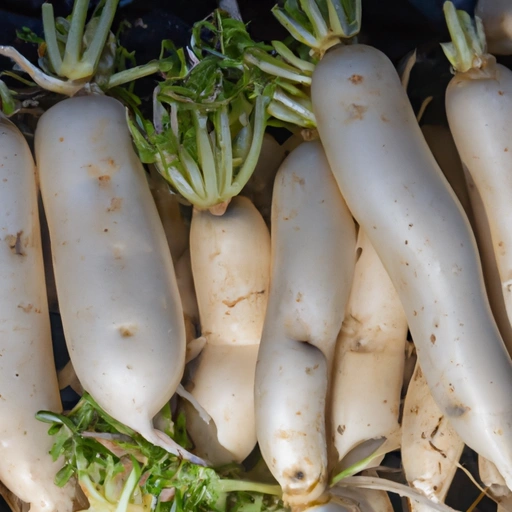Daikon
Description

Daikon, also known as white radish, Japanese radish, Chinese radish, winter radish, and luobo, is a mild-flavored, large, white East Asian radish (Raphanus sativus var. longipinnatus). With a juicy and slightly pungent taste, daikon is a versatile ingredient in many culinary traditions. It can be eaten raw, cooked, or pickled, making it an essential component in a wide range of dishes.
Common uses
Daikon is commonly used in salads, as a crunchy garnish, in soups, stews, and stir-fries, or pickled as a condiment. It can also be grated, sliced, or diced, offering a textural contrast in various dishes.
Nutritional value
Calories
Daikon is low in calories, with approximately 18 calories per 100 grams (3.5 oz).
Protein
It contains about 0.6 grams of protein per 100 grams (3.5 oz).
Fat
Daikon is virtually fat-free, with less than 0.1 grams of fat per 100 grams (3.5 oz).
Carbohydrates
It consists of about 4.1 grams of carbohydrates per 100 grams (3.5 oz), primarily in the form of dietary fiber and sugars.
Vitamins
Daikon is a good source of vitamin C, providing about 22 milligrams per 100 grams (3.5 oz), which is roughly 24% of the Daily Value (DV).
Minerals
It also contains essential minerals such as potassium, at around 227 milligrams per 100 grams (3.5 oz), and small amounts of calcium and iron.
Health benefits
Daikon is rich in vitamins, minerals, and antioxidants and is known for its digestive properties due to the presence of enzymes that aid in breaking down fatty foods and starchy carbohydrates. Its high fiber content also promotes a healthy digestive system.
Potential risks
For individuals with thyroid issues, excessive consumption of daikon and other cruciferous vegetables should be done with caution due to the presence of goitrogens, which can interfere with thyroid hormone production.
Common recipes
Daikon is often featured in recipes such as Japanese takuan (pickled daikon), Korean kimchi, and Chinese turnip cakes. It can also be found in Indian radish dishes like mooli paratha.
Cooking methods
The vegetable can be boiled, steamed, sautéed, or roasted. When pickled, daikon takes on a delightful tang and crispness, complementing the flavors of various Asian cuisines.
Pairing with other ingredients
Daikon pairs well with rich meats like duck or pork, seafood, rice, and other vegetables such as carrots, cucumbers, and seaweed. Its mild flavor and crisp texture make it an excellent counterpoint to stronger tastes.
Summary
Daikon radish is a dynamic and healthful ingredient with deep historical roots in Asian cuisine. It offers a range of uses from fresh, crunchy salads to hearty, cooked dishes. Its nutritional profile supports good health, providing essential vitamins and minerals while being low in calories and fat. Daikon is an ingredient worth exploring in kitchens around the world for its unique characteristics and benefits.